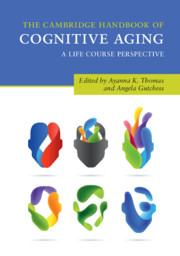Book contents
- The Cambridge Handbook of Cognitive Aging
- The Cambridge Handbook of Cognitive Aging
- Copyright page
- Contents
- Figures
- Tables
- Contributors
- Introduction
- Part I Models of Cognitive Aging
- Part II Mechanisms of Cognitive Aging
- Part III Aging in a Socioemotional Context
- 15 Memory and Aging in Social Contexts
- 16 Emotion Regulation in Adulthood and Old Age: A Cognitive Aging Perspective on Strategy Use and Effectiveness
- 17 Changes in Social and Emotional Well-Being over the Lifespan
- 18 Aging and Cognitive Functioning: The Impact of Goals and Motivation
- 19 Social Relationships and Cognitive Development in Adulthood
- 20 Emotion Recognition and Aging of the Social Brain
- 21 Narrative and Identity
- 22 Stereotype Threat and the Cognitive Performance of Older Adults
- Part III Summary: Aging in a Social Context
- Part IV Cognitive, Social, and Biological Factors across the Lifespan
- Part V Later Life and Interventions
- Index
- Plate Section (PDF Only)
- References
20 - Emotion Recognition and Aging of the Social Brain
from Part III - Aging in a Socioemotional Context
Published online by Cambridge University Press: 28 May 2020
- The Cambridge Handbook of Cognitive Aging
- The Cambridge Handbook of Cognitive Aging
- Copyright page
- Contents
- Figures
- Tables
- Contributors
- Introduction
- Part I Models of Cognitive Aging
- Part II Mechanisms of Cognitive Aging
- Part III Aging in a Socioemotional Context
- 15 Memory and Aging in Social Contexts
- 16 Emotion Regulation in Adulthood and Old Age: A Cognitive Aging Perspective on Strategy Use and Effectiveness
- 17 Changes in Social and Emotional Well-Being over the Lifespan
- 18 Aging and Cognitive Functioning: The Impact of Goals and Motivation
- 19 Social Relationships and Cognitive Development in Adulthood
- 20 Emotion Recognition and Aging of the Social Brain
- 21 Narrative and Identity
- 22 Stereotype Threat and the Cognitive Performance of Older Adults
- Part III Summary: Aging in a Social Context
- Part IV Cognitive, Social, and Biological Factors across the Lifespan
- Part V Later Life and Interventions
- Index
- Plate Section (PDF Only)
- References
Summary
We examine evidence for whether brain volume reductions and neurotransmitter decline can account for older adults’ emotion recognition difficulties relative to young adults. We also consider whether emotion recognition decline is related to general cognitive decline or the positivity bias. Despite recent claims, older adults’ emotion recognition difficulties are not consistent with the positivity bias. Links to general cognitive decline are not strong, although future research could shed further light on this issue by examining links to speed of processing. We conclude that there is some evidence for the idea that neurotransmitter decline might relate to older men’s emotion recognition declines (though not older women’s), but with only two studies, more research is needed. There are more studies examining brain volume reductions, with links between emotion recognition and decline in the frontal and temporal lobes clearest.
Keywords
Information
- Type
- Chapter
- Information
- The Cambridge Handbook of Cognitive AgingA Life Course Perspective, pp. 367 - 382Publisher: Cambridge University PressPrint publication year: 2020
References
Accessibility standard: Unknown
Why this information is here
This section outlines the accessibility features of this content - including support for screen readers, full keyboard navigation and high-contrast display options. This may not be relevant for you.Accessibility Information
- 3
- Cited by
